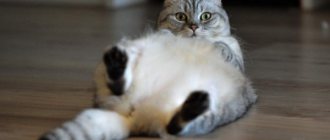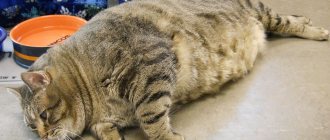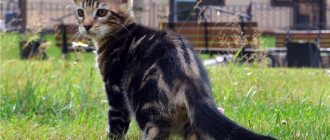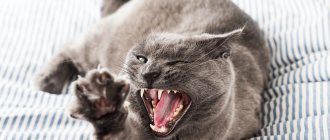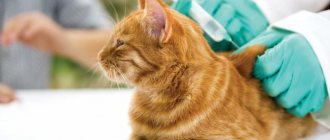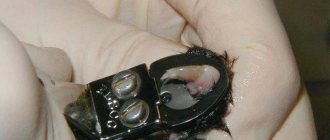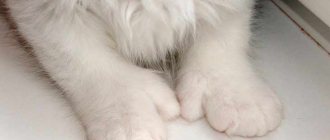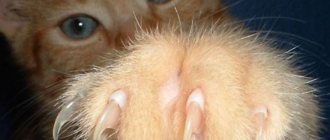Trimming your beloved pet's nails is a dual procedure. Someone constantly delays it, just to avoid outbursts of cat discontent and loud squeals. For some, giving their pet a pedicure seems like a real holiday. Much depends on the sleight of hand of the owner, on the temperament of the animal, and on a simple coincidence of circumstances. In order not to rely on the power of chance, let's talk about how to trim a cat's claws, avoiding heartbreaking dramas and assault.
How to trim a cat's claws
Purpose
Claws are vital for a cat, whether the pet is domestic or lives in the wild. Nature intended that with their help the animal obtains and cuts up food, defends itself and protects itself, and climbs onto the necessary surfaces.
The modern domestic cat also actively uses them. Of course, she doesn’t need to get food on her own. But instincts force her to sharpen them, thereby the keratinized cells fall off and the pet marks the territory, leaving a smell.
In addition, claws are an essential element in the structure of the skeleton; with their help, the animal feels balance and orients itself in space. Thanks to them, animals land softly and do not injure their limbs.
A haircut
Unlike their wild relatives, modern pets lead a less active lifestyle and do not have time to wear them down. They constantly grow back and even a scratching post is not effective.
The fifth toe on the front paws is especially dangerous; it is located higher than the rest and the claw is too long and can begin to grow in or prick the paw pads, causing pain. In addition to its own discomfort, the pet can cause damage to furniture or scratch its owners.
You can tidy up your animal’s paws yourself if you have the skills to use special scissors.
If you do not have experience trimming nails, it is better to consult a veterinarian.
Before starting the procedure, carefully examine the paw and claws; their ends are light and the base is dark - the pulp. It contains blood vessels and cannot be touched, much less cut. It bleeds blackish and can cause inflammation.
The circumcision process itself is painless, but some cats become nervous and even show aggression. Therefore, sometimes it is better to carry out manicure procedures together, so that one holds the pet and the other cuts the hair.
When trimming your nails, follow these guidelines:
- To begin, take the cat and calm it down, pet it, talk to it . Place him on your lap. Take the paw in your left hand (for right-handers), fix your pet’s finger between your thumb and forefinger, lightly press on the pad and a nail plate will appear;
- Determine the area of the nail from the pulp , it should be a light tip;
- The nail clippers should be positioned perpendicular to the nail and cut off the claw in one motion. If you place them parallel, this can lead to delamination of the plate;
- If sharp corners have formed, they can be cut off with a regular manicure file;
- All other claws should be trimmed using the same principle.
Functions of claws
Many people don't risk much interaction with this small predator. The cat's soft paws conceal razor-sharp claws. At every opportunity, she makes sure to release them. The purpose of a cat's claws is to protect itself from enemies and all sorts of enemies in the wild. A person’s home is a safe space, so the animal does not need to protect itself every minute with sharp scratches. However, pay attention to how jealously the cat guards its territory! She will not allow a random stranger to settle nearby.
Claws are as necessary for a little fluffy creature as having a roof over your head for a person. Only by possessing this unrivaled weapon can an animal truly feel confident. Cats that for some reason lack claws (as a result of injury, accident or abuse) evoke considerable sympathy. They do not have the ability to defend themselves and remain completely helpless in the face of the onslaught of external circumstances. This is why owners are not recommended to completely remove their pet’s claws. First of all, you should think about the animal: will it be comfortable to exist without claws? A person will never be able to take full responsibility for the life of his four-legged friend. By depriving an animal of “scratches,” you forever make it inferior.
Hello student
CLAW
The claw, unguicula, of dogs and cats consists of the following parts: the ungual process of the nail bone, processus unguicularis, the periosteum covering it, periost, and the dermis, sniffles, as well as the epidermis, epidermis, with keratinized and especially dense and hard parts in the wall area, paries , and soles, solea. Together with the digital pulp, torus digitalis, each finger represents a digital organ, organum digitate.
The horny substance of the claw surrounds the ungual process of the ungual bone on all sides like a capsule, and consists, like a human nail, of a strong wall, paries, and a thin elongated sole, solea. Distal from the tip of the claw process there is a space between it and the horny parts of the wall and sole, filled with terminally located horny substance. The proximal edge of the strong wall, especially in cats, has a deep groove of the ungual bone, sulcus unguicularis, which provides optimal anchorage and fixation of the claw.
Separate sections of the living matrix of the epidermis of the claw are located next to each other, and the elements of the horny substance formed from them in separate sections of the claw are located one above the other. In order to better study the elements of the horny substance of individual areas of the epidermis of the skin, their growth, the epidermis with its living matrix, matrix, and the underlying dermis, corium, is divided into separate segments, segmente. From the point of view of comparative anatomy, first of all, attention should be paid to the different formation of the structures of the dermis and epidermis. Using modern methods of preparation and research, it was possible to clearly distinguish the individual segments of the dog's claw, compare them and find similarities with the segments of the hoof and claw that have been studied for a long time (Budras/Seidel, 1992). Therefore, in the claw of a dog and cat, as well as in the hoof of ungulates, one can distinguish a border, corolla, wall and sole.
At the transition from the unchanged skin of the finger to the proximal edge of the claw, the skin forms a fold, border, limbus or ridge vallum, with sharp edges, the outer part of which still has all the components of the skin. The inner part without hair and glands is located along the inner surface of the claw crest, crista unguicularis, in the depth of the claw groove, sulcus unguicularis, and is comparable to the border of the hoof or claw, therefore they are called similarly, the border. The corolla is located at the base of the ungual process, processus unquicularis, has approximately the same width as the crista unguicularis above it, and extends from the dorsal side along the ungual process in all directions to the flexor tubercle, tuberculum flexorium. The wall is attached distally to the corolla and covers the dorsal as well as both lateral surfaces of the claw process. Compared to other segments, the dermis of the wall does not have papillae, but plates, leaflets, of varying heights and lengths. On the thin concave surface of the ungual process, the epidermis and dermis form the sole.
For intensive supply of the dermis with vessels and nerves in the depths of the sulcus unguicularis and on the processus unguicularis in dogs and cats, on each claw bone on both sides of the tuberculum flexorium there is a wide plantar opening, foramen soleare. Through it and the numerous openings of the claw process, the branches of blood vessels and nerves reach the dermis.
Because of the significant differences in nail shape between dogs and cats, these organs are considered separately.
The main component of a dog's claw is the most pigmented, durable wall, slightly convex in the longitudinal direction and significantly convex in the transverse direction.
Rice. 1. Front paw of a German Shepherd. View from the lateral side. 3/4 magnitude (according to Zietzschmann, 1943)
a claw; b the most distal hair of the outer part of the claw border; from the outer part of the claw border, the hair is cut; d finger crumb; e crumb soles
Rice. 2. Sagittal section of the dog’s forelimb finger. Magnification 2 times (according to Nickel et al., 1984) A proximal phalanx; B middle phalanx, C distal phalanx, ungual bone; D. E sesamoid bones; F common digital extensor tendon; C tendon of the deep flexor digitorum, N tendon of the superficial flexor digitorum; I middle annular ligament cut off
a hairy skin, a' the inner edge of the claw, b the wall of the claw, b' the sole of the claw; from the dermis of the thickened part of the dorsum of the claw, from the dermis of the sole; d the border between the sole and the toe crumb; e subcutaneous connective tissue of the digital crumb; f epidermis of digital crumb
1 coronal joint (proximal interphalangeal joint of the hand), 1′ dorsal, 1″ palmarnosus expansion of the articular capsule; 3 elastic dorsal ligament (ligamcntum dorsale) of the claw joint; 4 tendon sheath of the deep digital flexor tendon; 5 claw ridge; 6 claw border
Rice. 3. The inner surface of the claw capsule cut longitudinally (in the median plane) (above) and the surface of the dermis (below) after removing half of the claw capsule (but Budras Seidel, 1992)
The claw ridge, crista unguicularis, is shortened; W claw border; Z finger crumb
1 horn border, 1′ border; 2 corolla horn, 2′ corolla; 3 horn of the wall, 3′ wall with a thickening of the back, b proximal and distal lateral parts; 4 horn sole, 4′ sole; 5 terminally located horn, 5' terminal papillae. Enlarged 2 1/4 times
Rice. 4. Cross-section of a dog’s claw in the middle of the length of the claw process. Enlarged 2 1/2 times (after Siedamgrotzky, 1870)
a ungual process, b thickening of the back with the dermis of the wall on the curved back of the ungual process, c periosteum and dermis of the wall on the lateral part of the ungual process; d periosteum and dermis of the sole; e wall of the claw; f its epidermal cells; g claw sole horn
The wall extends from the depth of the border of the ungual bone, which is 5 mm thick, to the free end of the ungual process of the ungual bone, passing above it. During growth in length, the wall extends along the claw process, curved in the longitudinal direction, and with mechanical action, blunting of the tip of the claw, it also becomes equally dull. Both lateral edges of the wall reach the border on each side of the tuberculum flexorum of the claw bone and then follow together to the tip of the claw. The thickness and density of the wall of the claw on its back is greatest, and both lateral parts towards the free edges of the claw are thinner. The lateral parts of the tip of the claw are more worn than the central part. On a sufficiently worn dog's claw, the end surface forms not a straight line, but an acute angle with the axis of the claw process. This is something to keep in mind when trimming long nails on dogs. To determine the location of the tip of the claw, covered with periosteum and dermis, you should know that the ratio of the length of the process from the free edge of the claw border to the outer transverse diameter of the claw is 2:1. The horny substance of the claw of small breeds of dogs is stronger than that of large breeds (Siedamgrotzky, 1870).
The structure of the proximal half of the horn, the wall of horn tubes and the intermediate tubular horn, is well defined. Distally, these structures are less distinguishable and are not identified near the tip of the claw. Living cells of the epidermis, or its matrix, from which horn cells are formed, are located on the dermis at the base of the claw process and together form the corolla. In medium-sized dogs, the corolla on the dorsal side reaches a width of 3 mm, decreases on the lateral surface of the claw process palmar and plantar and ends on the side of the flexor tubercle, tuberculum flexorum, in the form of a ribbon 1 mm wide. The length of the papillae of the corolla dermis on the dorsal side reaches 350 µm and further increases towards the palmar and plantar sides. Forming from the matrix, keratinizing cells in the form of horny tubes and an intermediate tubular horn are constantly displaced towards the tip of the claw. Due to the formation of the horn in the corolla region, the horn moving from there along the wall is also called the corolla horn (-/2).
Rice. 5. Sagittal section of a cat's claw. Inner part. Enlarged 4.5 times (according to Siedamgrotzky, 1870)
a the region of the dermis of the corolla at the base of the claw process, a' the wall of the claw; b area of the dermis of the wall; c area of the dermis of the sole; d sole horn and terminal claw horn
The border (-/1′) corresponds to the hairless and glandular inner leaf of the hoof border and extends from the free edge to the transition to the corolla deep in the claw border. From the matrix of the epidermis of the border, a soft horn of the border (-/1) arises, which, on the one hand, covers the wall and grows with it in the distal direction, and on the other hand, provides an elastic seal of the border between the hard claw and the soft border. Due to the soft consistency, during normal abrasion of the claw, the horn of the border comes off the surface even before reaching the tip of the claw.
A wall adjoins the dorsal surface, as well as both lateral surfaces of the claw process distal to the corolla. On the side, the dermis of the wall connects with the periosteum of the claw process and in the proximal part has low, 5 µm high, and in the distal part already macroscopically visible, 300 µm high, longitudinally oriented leaflets. On the dorsal surface of the claw process, with a significant accumulation of connective tissue between the periosteum and the dermis, a noticeable thickening of the back is formed, which begins with a wide part proximally, and ends distally with a narrow part, sharply. On its surface, the leaflets of the dermis reach 200 microns in height. The cells of the epidermis of the wall become keratinized not only between, but, above all, above the leaves of the dermis. Due to this, a strong connection is formed between the dermis and epidermis of the wall. The inner surface of the wall is smooth. The distal edge of the leaflets of the dermis of the wall has papillae. Due to the matrix located on them, a terminally located horn is formed. This soft horn, arising on the granular layer of the epidermis, fills the space distal to the tip of the ungual process of the ungual bone between the distal part of the wall and the sole. Its deep part is gray, soft and can be easily cut with a knife. The more it adheres to the surface, the more indistinguishable the tubular structures become, and macroscopically it becomes lighter and more fragile.
Rice. 6. Cross-section of the cat's claw and claw at the border (A) and near the end of the dorsal thickening (B). The claw process is enlarged 8 times (according to Siedamgrotzky, 1870); b bone; c periosteum and dermis of the wall on the lateral parts of the ungual process, c' thickening of the back with dermis of the wall on the convex back of the ungual process; d periosteum of the inner surface of the claw bone; e skin; f claw wall, f' its epidermal cells; g periosteum and dermis of the sole; h horn of the sole of the claw
The sole is thin, located between the free edge of the wall and complements the terminal part of the claw on the palmar and plantar sides. The dermis of the sole (-/4′) is located in the form of a thin strip on the convex surface of the ungual process and has papillae, which can reach a length of 500 µm in the area of the tip of the ungual bone. The horn of the sole, built from the matrix of the epidermis, has a rubber-like consistency in the deep layers and, microscopically, a tubular structure. In the superficial, older part, the tubular structure is indistinguishable; this part is loose, soft and easily separated in layers (Siedamgrotzky, 1870; Dobler, 1969; Budras Seidel, 1992).
The generally unpigmented claw of a cat, like the short ungual process of the ungual bone, is larger than that of dogs and is strongly compressed laterally. The very thin sole horn and the terminally located wall horn, as well as the border, are comparable to the corresponding structures of the dog. The horn wall has a layered structure. Several factors play a role in maintaining the sharpness of the claw tip. In the area of the thin and strongly curved back of the claw, the horny substance, in comparison with the lateral parts of the claw, is much denser. The thickening of the back with the distally located free tip of the claw process is higher in a cat than in a dog, and the epidermal matrix lying above it makes it even higher than in a dog. dogs. On the structures that superficially increase the connection of the dermis and epidermis, in the region of the dermis of the wall there are a small number of leaflets up to 70 μm in height, and on the dermis of the sole there are papillae, the length of which ranges from 40 to 70 μm (Siedamgrotzky, 1870).
When grinding a claw, the edges of the thin side parts of the wall, which have a low growth rate, like the tip of the claw, along with the surface layers of the wall, are displaced, and the tip of the claw remains sharp. If the claws are not ground down, they contribute to strong stretching of the claw joint due to the elastic dorsal ligaments in the skin pockets located above the claw joints. These dorsally located pockets of skin on each finger are deeper abaxially than axially. Good coordination of the digital flexors allows the cat, when flexing a digital joint, either to release the claws (flexion of all digital joints when contracting the m. flexor digitalis profundus), or leave them in the dorsal digital bags of the deep flexor digitorum (flexion of only one digital joint when contracting the superficial digital flexor, m flexor digitalis superficialis). The boundary between the claw and the claw pulp is constructed similar to that of dogs.
In newborn dogs and cats, to protect the mother’s birth canal from damage, the claws are blunt and all horny parts are soft. During drying processes, they become stronger, and the tip of the claw, due to mechanical abrasion, takes on its final shape. In addition, by the time of birth, the soft horn of the sole and the terminally located horn fill the entire space up to the not yet ground down lateral edges of the claw wall.
Forelegs
How many claws does a cat have on its paws? Logic dictates that there should be twenty of them. Are you sure you know the correct answer? I would like to warn those owners who immediately rushed to count the number of claws on their pets. You may be very surprised, but their number on the front and hind legs is not the same. Many people believe that animals have five claws on each paw. This is not entirely true. The cat's front paws are actually equipped with a total of ten claws. But then things get very interesting.
Hind limbs
A surprise awaits the curious owner here. Instead of the usual five fingers, only four are detected. Some people are so shocked by this fact that they spend a long time fiddling with their pet’s soft paws, amazedly trying to find the missing fifth “element.” He is not there and cannot be. Finally, leave your pet alone, stop torturing him!
If your friends ever ask how many claws a cat has, now you know what to tell them in response. When the opportunity arises, you can show off your erudition with a smart look. As a result, it turns out that many people are mistaken about how many claws a cat has on its 4 paws. The pet has eighteen of them in total: five on the front legs and four on the hind legs. Quite unexpected, but it's true.
Is nail care necessary?
Some owners do not pay any attention to the physical condition of their pet. Of course, this approach cannot be called correct. Like the fur, the condition of the teeth and claws must be carefully monitored. In case of the slightest ailment or suspicious neoplasms, it is recommended to consult a veterinarian. It is not enough to simply have an idea of how many claws a cat has. You need to know how to care for these sharp “razors.” How to do it?
Firstly, a cat’s claws need to be trimmed no more than once or twice a month. Don't get too carried away with this matter. You don't want to leave your pet without any protection, do you? Secondly, the pet must be given the opportunity to sharpen its “scratches” every day. To prevent the animal from damaging the furniture, purchase a special scratching post. This will make everyone calmer. And your pet purr will certainly thank you for such touching care.
Step-by-step instructions for trimming nails at home
So, the instruments have been purchased, drugs to stop possible bleeding are at hand, a treat for a calm procedure, too, where to start the manipulation?
If the procedure is being carried out for the first time and the dog owner is not confident in trimming the nails correctly, it is better to first contact a veterinary clinic. The veterinarian will show you how to properly hold the tool and trim the claw.
Preparation
Before the grooming procedure, the dog must be walked and fed. It is advisable, especially with a nervous dog, that the walk is good and the dog is tired.
The nail trimming procedure should be carried out when the dog is in a calm state and in a familiar environment.
During the manipulation, you need to talk to the dog and calm it down so that it does not get nervous and accidentally harm itself by pulling its paw. If the dog categorically refuses to give a paw, you need to gradually accustom him to the procedure: stroke the dog’s paw while talking and, if the dog does not remove his paw from under his hand, treat him with a treat. Gradually you need to take the paw in your hand, stroke it, and touch the fingers separately.
Many dogs are very sensitive to touch between the toes - there are nerve endings there and the dog may be ticklish and instinctively pull the paw out.
Of course, it is best to accustom one to cosmetic procedures from puppyhood - the puppy perceives all manipulations much calmer and, as an adult, accepts all procedures calmly.
Nail trimming
Taking the dog's paw in your hand, so that it is comfortable for both the dog and the owner, you need to carefully move one finger away without squeezing it, so as not to cause pain to the dog.
The claw should be cut at a 45 degree angle to the border of the blood vessel . If the vessel is not visible, then you need to trim the claw a little at a time, gradually moving upward. You need to trim dark claws about half a centimeter at a time, be sure to inspect the cut - if the tip of the claw is wet or has stopped peeling, then you need to stop trimming. If the claw continues to peel a little, then the vessel is deeper and you can continue to trim the claws or file them.
Each finger is processed this way. And you definitely need to remember to treat the rudimentary 5th toe - when walking it is not used in any way and does not wear down, which is why it is usually longer than the rest. If you leave this claw, it can grow in or break off, accidentally touching an object. Breaking off a nail is very painful for a dog and can lead to bleeding and infection of the wound.
It is better to start treating claws from the front paws, moving gradually from claw to claw. Every time the dog behaves calmly and does not pull out its paw, after each finger, it is necessary to praise and treat the pet with a treat - so that the procedure brings only positive impressions to the dog.
Treatment and prevention of wounds
If, however, during trimming the claws a vessel was touched and bleeding began, you need to quickly stop the bleeding.
- You can buy a special hemostatic powder at the veterinary pharmacy, which must be rubbed in until the bleeding stops.
- But you can get by with the usual means: treat the bleeding wound with hydrogen peroxide. Peroxide quickly and effectively stops bleeding.
- After stopping the bleeding, the wound is treated with an antiseptic - a chlorhexidine solution is perfect for this purpose: it can wash the wound and get rid of possible infection.
- If the bleeding does not stop within 30 minutes or more, the wound may be deeper or the dog has health problems - in this case, you should urgently take the dog to a veterinarian.
- Once the bleeding has stopped and the wound has been cleaned, a bandage can be applied. It is advisable to put any wound-healing ointment under the bandage - for example, mekol (or levomekol). To prevent your dog from tearing the bandage and licking the wound, you can wear a special veterinary cap.
The severity of the wound can be shown by the dog’s behavior - if the dog does not stand on its paw at all, then it is worth showing it to a specialist: perhaps treating the damaged claw alone is not enough and veterinary help is needed.
Why does a cat need claws?
Cats got their claws from their predatory ancestors.
First of all, cats need claws for balance and ease of movement while walking and running. They were inherited by pets from their predatory ancestors.
The claws have to be sharpened and cleaned, which is what pets do. As a rule, in these cases, cats often tear furniture, doors and other products that help get rid of dead cells.
As you know, predators need claws for hunting and cutting food . They also help bury the remains of prey.
Many owners trim the nails of their pets, because their pets do not live in the wild world, and they do not have to get food on their own.
How many claws do cats and cats have?
The number of claws in cats is equal to the number of toes on their paws.
As a rule, the number of claws in cats and cats is the same . According to many, pets have 20 claws, just like the fingers of a person himself. In fact, their number varies.
It is worth noting that the animal has two front and hind legs.
Cats have five toes on their front toes, but only four on their back.
One can only guess what caused this arrangement. There are fewer toes with claws on the hind paws, which provides them with more comfortable movement and allows them to slow down more easily and quickly. As is known, they use their front paws to cut up their prey.
What time can an animal have its claws removed?
Cat claws are an integral part of a natural lifestyle. They are needed for successful hunting, tree climbing, and self-defense. Unfortunately, some owners prefer cleanliness, order, intact furniture and wallpaper, so they turn to veterinarians with a request to remove the claws of their pet. This operation is called onychectomy. This very complex surgical procedure involves amputating the cat's phalanx of toes and claws.
In Russia, nail removal is called “Soft Paws”. However, the attitude of both veterinarians and most cat lovers towards the operation is negative. Having deprived their cat of protection, people are sometimes unaware of the unpredictable consequences for their pets. In some EU countries, onychectomy is prohibited by law, and a veterinarian who decides to perform such a risky operation may lose his license. This procedure is permitted only if there are special indications:
- If the cat's behavior is so aggressive that it causes injury to people or other pets.
- If there are physiological reasons related to your pet’s health.
The complexity of the operation and the severity of possible consequences are so great that only young and healthy cats can undergo onychectomy. Even with a quick and successful postoperative period, the future life of the furry will be disrupted. Removal of the phalanges of the fingers with claws leads to a reduction in the size of the paw and redistribution of the load on the musculoskeletal system. As a result, arthritis, joint displacement, and dysfunction of the vestibular apparatus will haunt the cat for the rest of its life.
Trimming cat claws: basic rules
If you don't trim your cat's claws on time, the wallpaper or sofa may be damaged.
Pets often tear up furniture, carpets, doors and other interior items, which causes losses for their owners.
Cats' paws and claws are quite strong, so they leave noticeable marks.
To prevent the animal from tearing up furniture and carpets, you need to provide it with a special place or places for its activities. Today, various posts and devices are sold so that the animal can sharpen its claws.
Still, many owners believe that it is easier to regularly trim their cats' claws so that they do not pose a danger both to the furniture itself and to children whom they may scratch.
Basic rules for trimming nails
A special nail clipper will help make the procedure easier.
- Claws can be trimmed at a veterinarian, in a cat salon, or independently. Use a special nail clipper , forceps or scissors.
- The cat may be in pain during the procedure, so be gentle with it and be as careful as possible .
- Haircuts are carried out once every 1–1.5 months .
- After trimming the claws, the area must be treated with an antiseptic , for example, hydrogen peroxide.
How to trim your nails yourself?
When trimming your nails yourself, you should follow simple rules.
More and more owners are trimming their animals’ nails themselves, since specialized pet stores sell the entire necessary arsenal of tools. First of all, you should buy special nail clippers . They have a special semicircular shape, which allows you to trim your claws as quickly and accurately as possible.
- Before the procedure, the animal must be petted, calmed and placed on your lap. It is also necessary to call an assistant so that the cat cannot escape and get hurt.
- Each claw must be carefully felt, pulled out, then brought in with a nail cutter, fixed correctly and quickly cut off the claw.
- Scissors or tweezers should be positioned perpendicular to the claw so that the cut is transverse and, therefore, brings less pain and discomfort to the animal.
- Afterwards you need to treat the cut site, especially if there is blood. At the end of the procedure, you need to carefully file the claws.
Cat's claw - beneficial properties and contraindications
The main effect that cat's claw has is to clean cells, remove excess fluid from them, and improve liver function, even with cirrhosis. It also supports the body in environmentally unfavorable areas, helps with poisoning, regardless of whether the cause is plant or alcohol poison.
What other beneficial properties does cat’s claw have:
- restores after chemotherapy or radiation therapy;
- removes toxins;
- relieves inflammation in internal organs and joints;
- significantly strengthens the immune system;
- blocks the growth and reproduction of cancer cells, helps overcome leukemia;
- prevents the formation of blood clots and plaques in blood vessels;
- improves blood pressure;
- destroys parasites along with larvae;
- quickly heals external wounds and internal damage, including ulcers.
Cat's claw - medicinal properties
The raw materials from this vine cannot be called cheap, and the reason for this is not only expensive foreign supplies, but also not very extensive production. Uncaria grows very slowly; in order for it to be suitable for creating a medicine, it must grow for at least 20 years. The list of its valuable properties includes antioxidant, anti-inflammatory, antiviral, and antitumor properties.
Having studied the cat's claw plant, researchers identify the most valuable medicinal properties as follows:
- destruction of tumor cells;
- improvement of blood condition;
- blocking viruses in cells;
- the ability to block the formation of free radicals without side effects.
Cat's claw - indications for use
The timing of how long to take cat's claw depends on the diagnosis and condition of the patient; on average, the time is limited from a month to three. It is known that the inhabitants of Peru used the plant to treat stomach and intestines, colds, joint diseases and even impotence. Scientists explain the strong immunostimulating effect, which surpasses even ginseng, by the fact that the medicine acts on the body at the cellular level.
What are the indications for use of cat's claw:
- viral and bacterial infections;
- allergy;
- inflammation;
- oncology;
- ulcer;
- hormonal imbalance;
- arthritis;
- diabetes;
- skin diseases;
- pain in muscles and joints;
- blood diseases;
- poisoning;
- mental and nervous system problems;
- menstrual pain, gynecological problems;
- flu;
- herpes;
- thrombophlebitis;
- varicose veins;
- AIDS virus.
Cat's claw - contraindications
Cat's claw also has properties to treat genital herpes, hepatitis, chlamydia, and without relapse, it improves digestion and heals the gastric mucosa. But even with all its healing abilities, it cannot be used by everyone, without exception. The drug should not be given to pregnant women, as it can cause uterine contractions and miscarriage, to nursing mothers, and to children. It is known that Peruvian women used decoctions as a contraceptive.
In what cases is cat's claw strictly contraindicated:
- tuberculosis;
- autoimmune diseases;
- hypertension;
- during organ transplantation, rejection may begin;
- when taking medications that relieve heart rhythm disturbances;
- when taking blood thinners;
- before going to the dentist.
What you need to know about nail trimming?
Before you start trimming your pet's nails, weigh the pros and cons. It is advisable to accustom young kittens to trim their claws, who will eventually become completely accustomed to this procedure . If you decide to cut the claws of an adult cat, then he is unlikely to understand this, and besides, he may be very offended by you and not allow himself to be stroked.
It is worth noting that nail trimming is mandatory for show animals and cats participating in castrati shows.
Summarize
- Cat's claw is a popular herbal supplement derived from a tropical vine.
- While research to support many of the purported benefits is limited, some evidence suggests that cat's claw may help strengthen your immune system and reduce the symptoms of osteoarthritis and rheumatoid arthritis.
- Since safety and dosage recommendations have not been established, it is best to consult your doctor before taking cat's claw.
Tags: Cat's claw
- Related Posts
- How to get vitamin D: effective ways
- When is the best time to take probiotics?
- Vitamin D: why women, men and children need it
« Previous entry

